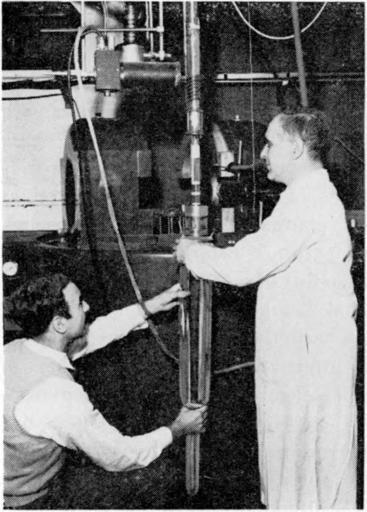MAKE A MEME
View Large Image

| View Original: | Wu_experiment_at_Bureau_of_Standards.jpg (859x1200) | |||
| Download: | Original | Medium | Small | Thumb |
| Courtesy of: | commons.wikimedia.org | More Like This | ||
| Keywords: Wu experiment at Bureau of Standards.jpg Wu experiment an elementary particle experiment performed by American physicist Chien-Shiung Wu at the US National Bureau of Standards now NIST in 1956 that established the nonconservation of parity in elementary particle reactions involving the weak force Tsung-Dao Lee and Chen-Ning Yang the theoretical physicists who originated the idea of parity nonconservation and proposed the experiment were awarded the 1957 Nobel Prize in physics for this result In the experiment the intensity of gamma rays emitted by the radioactive isotope en cobalt 60 cooled to near absolute zero and placed in a magnetic field was measured The picture shows the column containing the cobalt-60 detectors and magnetizing coil being slid into a glass Dewar flask before being inserted in the large magnet in background which will cool the sample to cryogenic temperatures <br /><br /> Caption Low temperature experiments at the Bureau demonstrated that the quantum mechanical law of conservation of parity does not hold in the beta decay of cobalt-60 nuclei Apparatus used in the parity studies An outer dewar flask is being place on a glass vacuum chamber containing a sample of radioactive cobalt-60 The large magnet in the background cools the sample almost to absolute zero by adiabatic demagnetization The magnetic field of a solenoid is then used to polarize the cobalt nuclei 1957 Retrieved January 29 2014 from http //books google com/books id 2d1th30kedoC pg RA2-PA22 Annual Report of the National Bureau of Standards for 1957 miscellaneous publication 227 US Government Printing Office Washington D C p 22 reprinted in Research Highlights of the National Bureau of Standards on Google Books A V Astin Director Bureau of Standards CleanFFT PD-USGov Uploaded with UploadWizard Spin intrinsic angular momentum Physics experiments | ||||